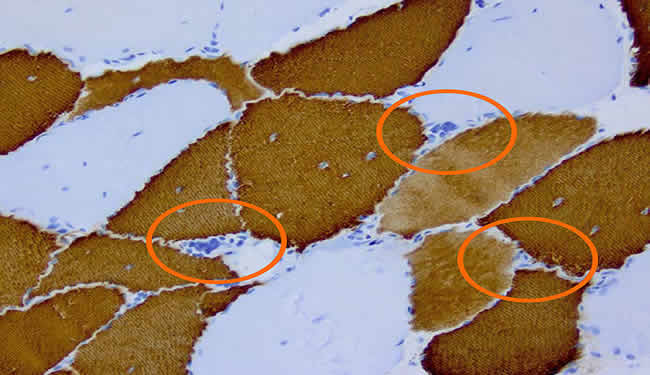Recent findings by an international collaboration including IRCM researchers hold new implications for the pathogenesis of myotonic dystrophy.
An important breakthrough could help in the fight against myotonic dystrophy. The discovery, recently published in the prestigious scientific journal Cell, results from an international collaboration between researchers at the IRCM, the Massachusetts Institute of Technology (MIT), the University of Southern California and Illumina. Their findings could lead to a better understanding of the causes of this disease.
Myotonic dystrophy (DM), also known as Steinert’s disease, is the most common form of muscular dystrophies seen in adults. This disorder is characterized by muscle weakness and myotonia (difficulty in relaxing muscles following contraction). It is a multi-system disease, typically involving a wide range of tissues and muscle.

“We studied a specific family of proteins called muscleblind-like proteins (Mbnl), which were first discovered in the fruit fly Drosophila melanogaster,” says Dr. Éric Lécuyer, Director of the RNA Biology research unit at the IRCM. “These RNA-binding proteins are known to play important functions in muscle and eye development, as well as in the pathogenesis of DM in humans.”
Because of the extreme heterogeneity of clinical symptoms, DM has been described as one of the most variable and complicated disorders known in medicine. The systems affected, the severity of symptoms, and the age of onset of those symptoms greatly vary between individuals, even within the same family.
“In patients with DM, levels of Mbnl proteins are depleted to different extents in various tissues,” explains Dr. Neal A.L. Cody, postdoctoral fellow in Dr. Lécuyer’s laboratory. “These alterations in levels and functions of Mbnl proteins are thought to play an important role in causing the disease.”
“The global transcriptome analyses conducted in this study yielded several insights into Mbnl function and established genomic resources for future functional, modeling, and clinical studies,” add Drs. Christopher B. Burge and Eric T. Wang from MIT, the researchers who headed the study. “This knowledge will be invaluable in reconstructing the order of events that occur during DM pathogenesis, and could lead to the development of diagnostic tools for monitoring disease progression and response to therapy.”
According to Muscular Dystrophy Canada, myotonic dystrophy is the most common form of muscle disease, affecting approximately one person in 8,000 worldwide. However, in Quebec’s region of Charlevoix / Saguenay-Lac-Saint-Jean, the prevalence is exceptionally high, with one person in 500 affected by the disease. There is no cure for myotonic dystrophy at the present time. Treatment is symptomatic, meaning that problems associated with myotonic dystrophy are treated individually.
Notes about this muscular dystrophy research
This research project was funded by grants from the National Institutes of Health (NIH) to Christopher B. Burge and by an NIH training grant and a Muscular Dystrophy Foundation fellowship to Eric T. Wang. Work conducted by Neal A.L. Cody in Dr. Lécuyer’s laboratory was funded by the Fonds de Recherche du Québec – Santé.
The article published in Cell, Transcriptome-wide Regulation of Pre-mRNA Splicing and mRNA Localization by Muscleblind Proteins, was prepared by Eric T. Wang, Thomas T. Wang, Daniel J. Treacy, David E. Housman and Christopher B. Burge from the David K. Koch Institute for Integrative Cancer Research at the Massachusetts Institute of Technology (MIT); Neal A.L. Cody and Éric Lécuyer from the IRCM; Sonali Jog, Michela Biancolella and Sita Reddy from the University of Southern California; and Shujun Luo and Gary P. Schroth from Illumina Inc.
Contacts: Julie Langelier – Communications Officer (IRCM)
Lucette Thériault – Communications Director (IRCM)
Source: Institut de Recherches Cliniques de Montreal (IRCM) press release
Image Source: Myotonic dystrophy image adapted from image by Marvin 101 (Own work) CC-BY-3.0 via Wikimedia Commons
Original Research: Abstract for “Transcriptome-wide Regulation of Pre-mRNA Splicing and mRNA Localization by Muscleblind Proteins” by Eric T. Wang, Neal A.L. Cody, Sonali Jog, Michela Biancolella, Thomas T. Wang, 3, Daniel J. Treacy, Shujun Luo, Gary P. Schroth, David E. Housman, Sita Reddy, Eric Lécuyer and Christopher B. Burge in Cell 17 August 2012 Volume 150, Issue 4, 710-724 doi:10.1016/j.cell.2012.06.041







